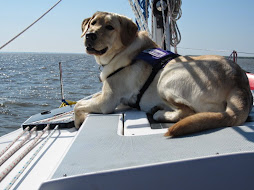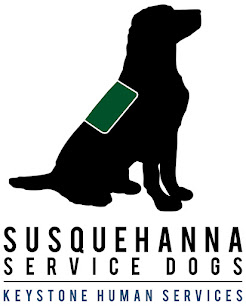When our puppy raisers are handed one of our puppies, they
become responsible for training that dog for the first 12-18 months of his
life. Puppy raisers teach the dogs the basic service dog cues and good house
manners, as well as take the dogs out in public to gain as many experiences as
possible. But what are these basic cues? For a service dog, the basics involve
a little more than “sit” and “stay.”
Our puppy raisers are responsible for teaching their puppy
26 cues. We cover 10 of these cues in puppy class. The other 16 are detailed in
the puppy manual that each puppy raiser receives, and raisers can always ask
one of our trainers or veteran puppy raisers for help with a cue. We’re always
happy to help!
Here are the 26 cues that form the foundation of every
Susquehanna Service Dog:
All the way up
The dog puts all four paws on an object.
Back
The dog walks 5-7 steps backward. Dogs that don’t know
“back” will be limited in their placement. For example, a dog that doesn’t know
“back” can’t open a door and therefore can’t be placed with someone in a
wheelchair.
Car
“Car” cues the dog to jump into the car. The dogs need to
practice getting in and out of cars, vans, SUVs, trucks, etc., and they should
be able to get in through any door, including the trunk in a van or SUV.
Recalls (come)
A good recall can save a dog’s life. Our dogs practice
recalls inside and outside in many different situations and environments.
Comfort trainer
Depending on their placement, a dog may wear a comfort
trainer. For example, all of our balance dogs wear comfort trainers to give
their partners more control over the dog. We want to make it as easy as
possible for our partners to dress their dog for work, so we train our dogs to
put their snout through the comfort trainer and hold it there while their partner
secures it.
Down
The dog lies down and rolls their hip.
Easy
“Easy” cues the dog to take treats nicely. This is
especially important if the dog is going to be placed with a child.
Fix
The dog untangles himself from the leash.
Get busy
The dog potties on cue, on any surface on and off leash.
Again, this is an important cue. We never know where a dog is going to be
placed. A dog living in the city won’t necessarily have the luxury of a nice
patch of grass, so they’ll need to be comfortable going on concrete or asphalt.
Get dressed
This is another cue that’s helpful for partners who have
limited mobility. On cue, the dog puts his head through the harness and stands
still while it’s buckled.
Go on through
The dog goes through an opening, turns around, and looks
that the handler, without pulling to the end of the leash. “Go on through” can
be used to go through doorways, maneuver through aisles or other tight spaces,
or even simply have the dog turn around in an open space.
Go to bed
We have found that many of our partners use the “go to bed”
cue. “Go to bed” means the dog goes to a designated bed or towel, lies down,
and stays there until released. Our facility dogs perform this cue a lot when
they’re not needed with the students. It also lets the dog know that it’s time
to relax.
Heel
On the cue “heel,” the dog moves to stand on the handler’s
left side. “Heel” takes a long time to train because there are so many steps to
it. We train it using a box. The dog puts her front paws on the box and we click
and treat her for moving her back feet around the box.
Kennel
The dog walks into her crate and stays there, regardless of
whether the door is open. The dog should be able to do this whether or not the
handler is in the room. All of our dogs are crate trained, and while the dog is
in the crate, she should be quiet and relaxed, even if there are other
activities going on around her.
Lap
Every single dog that we place learns this behavior, and
it’s a favorite among our partners. On cue, the dog rests her front legs in the
handler’s lap. The dog should be able to do this from either side. Lap can be
used to give pressure to relieve anxiety, or as a way to a dog to deliver an
item to someone in a wheelchair. It’s also a great way for handlers to pay
attention to their dog.
Leave it
“Leave it” is a behavior that never ends. We are always
working on it with our dogs. A good “leave it,” like a good recall, can save a
dog’s life. We start training this cue by holding a piece of kibble in a closed
fist and clicking the dog for looking away from the fist. Eventually, the dog
should be able to walk by anything interesting on the floor, tables, chairs,
etc. and ignore it. We encourage our puppy raisers to continue practicing all
of the steps, even if their dog has a solid “leave it.” In Team Training, we
show our partners how to work on “leave it” from the very beginning steps, and
it’s always easier to have a dog that remembers it.
Let’s go
The dog begins to walk next to her handler.
Name
At Susquehanna Service Dogs, the dog’s name is a rewardable
cue. Whenever our puppy raisers say their dog’s name, the dog should look at
them and they should be rewarded for it. This is why we don’t train a “look at
me” type cue. The dog’s name is the cue to look at their handler.
Off
“Off” should only be used if a dog has put their paws on
something they’re allowed to be on. For example, if you invite them up on the
couch and now you want them back on the floor, you would say “off.” You could
also use it to ask your dog to leave your lap. “Off” should not be used if the
dog is doing something they shouldn’t be doing. For example, if they put their
paws up on the counter. In that case, you would simply take their collar and
guide them off the counter without a cue.
Okay
“Okay” is the word that releases a dog from a behavior. For example, we
use it to tell a dog they can come out of their crate, and we use it to release
a dog to eat.
Paw
The dog puts their paw in your hand. This can be a useful
cue for nail clipping and grooming.
Side
“Side” is the opposite of “heel.” The dog moves to stand
next to their handler on the right side. We teach it the same way we teach
“heel.”
Sit
“Sit” is probably one of the most basic cues. It’s also one
of the easiest cues to forget to practice once a dog learns it. However, it’s
important to continue practicing solid sits so that the dog actually does a
“sit” rather than sliding right into a “down.”
Stay
“Stay” tells the dog to remain exactly where they are. The
dog should be able to perform this behavior in a sit, down, and stand. There
are two types of stays. One is a cued “stay” where the dog stays alert to his
handler. The other is a relaxed stay that may or may not have been cued. The
handler is busy doing something else, and the dog just relaxes in a down and
maybe even falls asleep.
Stand
The dog stands with no movement. The dog shouldn’t stand and
then sit, or stand and move around. To get a solid stand, delay the click after
giving the cue. The dog will most likely stay still until they hear the click.
Then simply delay the click longer each time so you’re actually clicking for
the standing and waiting in that position.
Under
The dog goes under an object, such as a bench, table, or
chair. Even big dogs can fit until low benches and chairs. “Under” gets the dog
out of the way of other people that may be passing by. It keeps people from
tripping over the dog, and it protects the dog from being stepped on.
Up
The dog puts two paws on an object. It can be hard for a dog
to distinguish between “up” and “all the way up,” so it may be helpful to
practice “up” against a wall and just have the dog put their feet against the
wall.
Visit
Visit is another favorite of our partners. Every single one
of our dogs learns this behavior. On cue, the dog puts her head in the
handler’s lap or hand.
When our dogs enter advanced training already knowing all of
these cues, they can jump right into the more advanced cues they’ll need to
assist their future partners.






























































